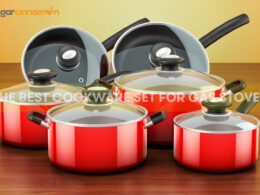Table of Contents Show
Are you shopping for new cookware? But can’t decide between made In and all-clad? Having the best cookware in the kitchen is important not just for chefs but also everyone who loves cooking. The made-in-cookware was introduced six years ago and it is regarded as premium quality cookware for anyone to go for.
All clad is a cookware that is made with five layers of metal and while this sounds interesting, it does cost more. When it comes to choosing the right cookware, you have to consider how often you cook, it will influence your choice of pans and pots.
Made In cookware’s increasing popularity is based on lots of factors some of which include its ability to perform well and remain durable over time. Your cooking technique might come in handy when you are choosing between made In and all-clad cookware and if you are also starting from scratch, there are the two brands you want to be looking at.
Your top priorities when you are buying kitchen cookware should be the material, quality, and cost. So, after contemplating these factors, you can compare brands that offer you the best in those regards. So, stick around for an evaluation of which is better between Made In and All-Clad cookware.
Made In Cookware Overview

Made In is known as one of the best cookware brands and the cookware has not 1, but 3 layers of thick aluminum sandwiched between the outer layers of stainless steel. This brand of cookware was made official in 2017 and most of its products are basic kitchen tools such as pans, pots, knives, and plates.
Their cookware is made in the United States while a few pieces are made in France and Italy. These cookwares are super durable and evenly distribute heat. The stainless steel has 5-ply cladding so it is designed to heat and cool quickly hence why it is favored by pro chefs.
Made in response quickly to changes in temperature as well and offers you cheaper sets and pricier ones which are the cheaper Starter Kit and pricier Executive Chef Set.
All-Clad Cookware Overview

All clad cookware on the other hand was founded in 1967 and it is one of the best brands in terms of quality and money. All clad is known to produce high-quality stainless steel cookware pots and pans and has been around for quite a long while. The key feature that sets All clad cookware apart is that the stainless steel layers provide exceptional corrosion resistance and durability.
Even heating is guaranteed with all clad cookware and as the name of the company implies, the fully clad cookware consists of layers of material clad together, there are stacked sheets of metal which are 3 or more to create the shape of a pan.
Today, all clad cookware is still handcrafted in Pennsylvania and Canonsburg with American-made steel just the way it was done when it was first created 5 decades ago. Made-in cookware also has a wide range of kitchen products to offer, there is a chance to get all your kitchen products from the same brand.
Made In vs All-Clad: In-Depth Comparison
Making up your mind between made-in and all-clad cookware can be quite confusing and this is often because both offer similar features in durability and value. No matter what complex recipe you are making, both cookwares can make things fun and easy. Below is an in-depth review and comparison of made-in and all-clad cookware.
| Key Features | Made In Cookware | All-Clad Cookware |
|---|---|---|
| Design | Made-in and all-clad cookware have a similar design but made-in lid handles are in shape, and with smooth, round edges | All-clad cookware and made-in are both equipped with steel lids, stylish riveted handles, and steel exteriors but the lid handles are like trapezoids. |
| Construction | Carbon steel Copper Stainless Steel Non-Stick Provides only a 5-ply construction | Ceramic Stainless steel Non-Stick Hard anodized aluminum Varies by collection |
| Where its made | USA | USA |
| Heat Conduction | Has a premium triple layer of an aluminum core | Has a single layer of an aluminum core |
| Free From | PFOA | PFOA |
| Oven Safety | Made in stainless steel is oven safe with a higher threshold of heat resistance compared to all clads. | All class stainless steel ranges are oven safe but the lids are not. |
| Price: | Made in is sold directly to customers so it is slightly cheaper compared to all-clad but does not compromise in quality. | All-clad is a premium high-end cookware so it is significantly higher in price. |
Made In vs All-Clad: Which Cookware Is Better?
After looking at the comparison table above, you can easily conclude which is better. However, it is also crucial that you consider which is favorable after looking at the factors that guide you when buying cookware.
So, let’s dive into a much deeper analysis of the comparison.
1. Construction And Materials
Both brands are similar in construction, they both produce fully clad stainless steel pots and pans but they have some differences. Made-in cookware is offered in only 5-ply construction while the all-clad tends to vary by collection.
Made In cookware provides three layers of heavy gauge aluminum and it meshes between stainless steel layers. All clad on the other hand comes with more variety in cookware construction. Both have durable interior cooking surfaces.
2. Heat Retention
The ability to retain heat is quite an important factor to consider when choosing the cookware. When comparing all clad and made-in, both are designed to conduct heat quickly and spread evenly across the cooking surface.
However, made-in cookwares are faster due to its premium triple layer of aluminum core while the all-clad collection has only a single layer of aluminum core.
3. Oven Safety
Another factor to put into consideration when choosing between all-clad and made-in cookware is oven safety. Made-in and all-clad are actually oven safe but their threshold heat resistance is different. The stainless steel made in cookware is oven safe and the lid is too and the all-clad stainless steel is oven safe too but not the lid.
Made-in stainless steel cookware is broiler safe up to 800 degrees F and the nonstick is safe up to 500 degrees F. The all-clad stainless cookware, on the other hand, is safe up to 600 degrees F and the nonstick variety is safe up to 500 degrees F.
4. Affordability
Finding friendly budget cookware is often neglected but it’s a very crucial factor. The all-clad cookware is more expensive than the made and this is because all-clad is sourced and produced in the US. The all-clad is a premium high-end cookware and is sold through a retailer while the made-in is sold directly to customers through their website.
Made in is more affordable but this has not compromised its quality in any way and it’s not cheap either compared to brands like Calphalon and Hexclad.
Frequently Asked Questions
Do chefs like All-Clad?
Yes, many chefs find all-clad cookware to be exceptional and unmatched in the distribution of heat and durability. It also gets consistently high marks from home cooks as they are also easier on your food’s flavor profile
What are the layers of made-in cookware?
Inside layers of made-in pots is aluminum which allows optimal heat conductivity. The outside is covered in stainless steel hence it is durable and non-reactive.
What should you not do with All-Clad?
Things you should not do with all clad cookware is to not use steel wool, steel scouring pads, or any harsh detergents when washing it. Also, before using the nonstick coating pan for the first time, wash in hot soapy water using a sponge or dishcloth.
Are All-Clad Stainless Steel and Made In Cookware Induction Safe?
Yes, all clad and made-in cookware is an induction safe but there is one exception. All clad makes copper core cookware for those who are looking to make premium dishes but note that copper is a bad conductor of heat from induction stoves so it’s the only exception.
Our Verdict
So, which is better? After hours of research and an ultimate comparison table, we do have to conclude that made-in cookware is better.
However, all-clad has its advantages and it will offer you a wonderful cooking experience. Still, made-in is the winner after looking at how both brands stack up in terms of quality, construction, price, and efficiency.












